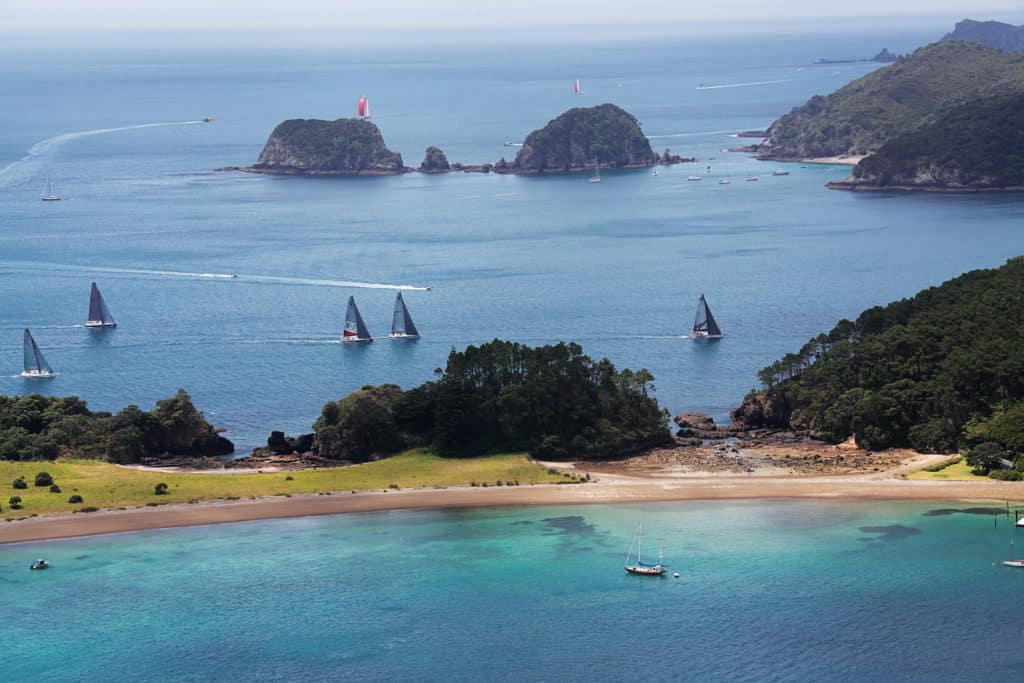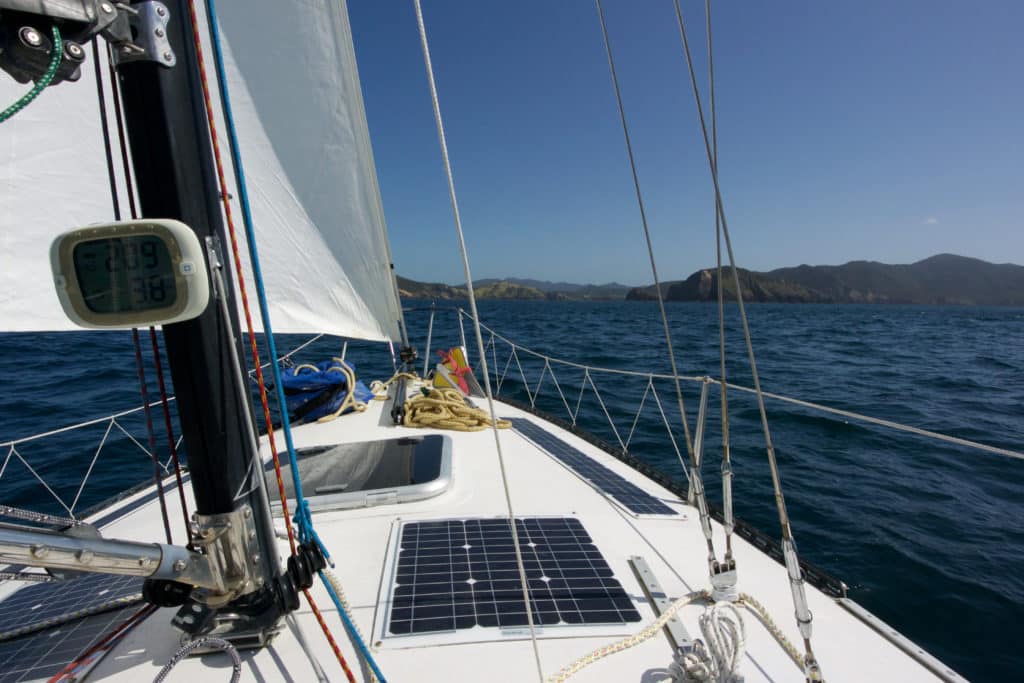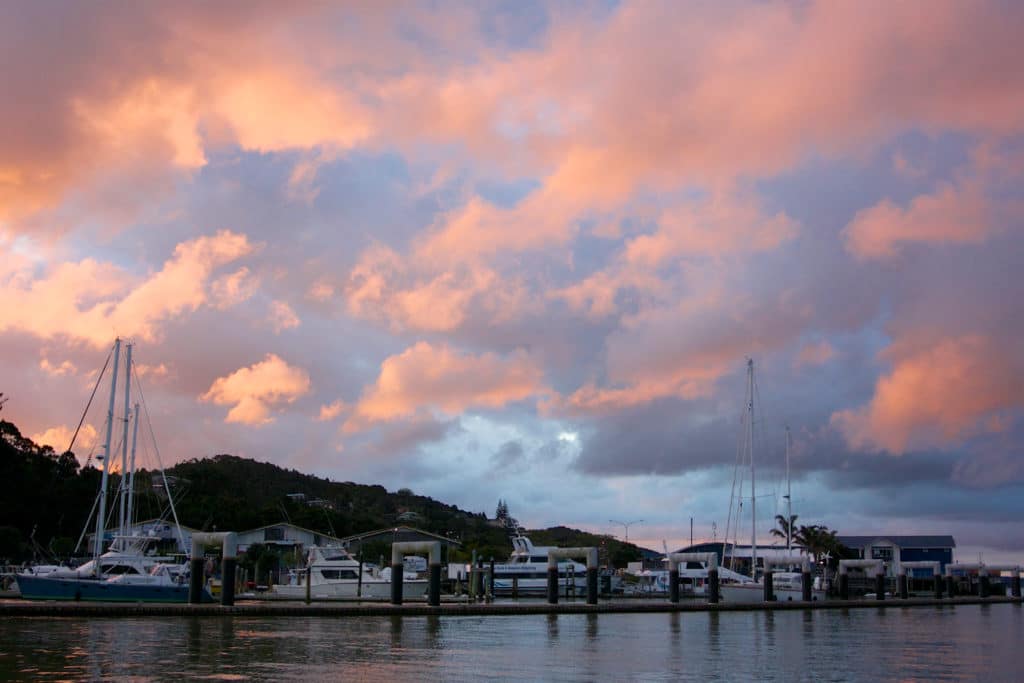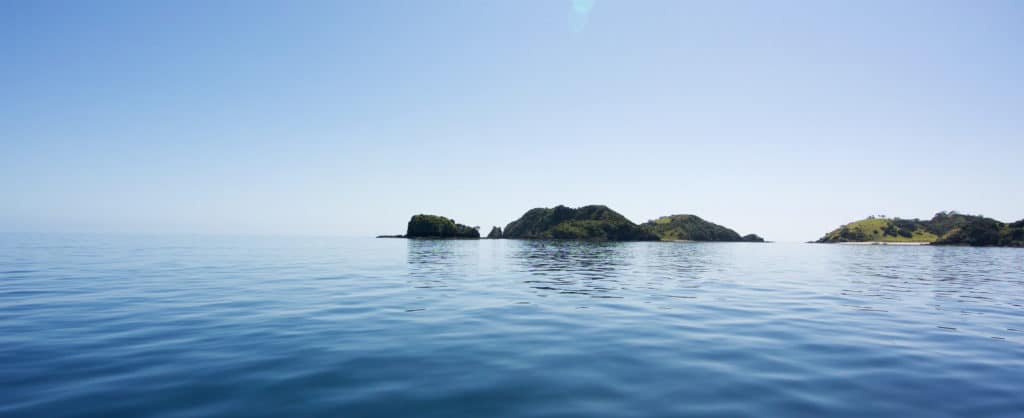
BAY OF ISLANDS SAILING WEEK
On the evening of October 6, 2015, I had paradise to myself — Paradise Bay, specifically, on the west side of Urupukapuka Island, in New Zealand’s Bay of Islands.
In 2014, I crossed the Pacific Ocean on Gannet, my Moore 24, sailing 7,000 miles. We had some 1,000-mile weeks and several 150-plus-mile days. Now I was trying merely to sail 25 miles from our mooring off Opua to Whangamumu Harbor, and there were times I didn’t think we’d make it.
Earlier that day, on a sunny, pleasant but windless morning, I had Gannet ready to sail, except for raising the mainsail and dropping the mooring, at 1000. I finally did drop the mooring at noon. The tide was coming in, keeping our bow to the north, and an almost imperceptible wind was from the south, so I raised the main with the wind behind us, went forward and released the mooring, and we headed north, slowly, on a dead run.
After a half-hour, I was able to raise the jib, and a few minutes later, the wind swung from south to north, heading us and increasing slightly.
I tacked and tacked Gannet, at one point almost running over another gannet preoccupied with preening his feathers. It took us an hour and 45 minutes to be off Russell — a straight-line distance of less than 4 nautical miles. Then the wind increased again for a while, and we sometimes saw boat speeds of 5 knots.
As I sailed past Roberton Island, I considered calling it a day and going in, but glided on and got the anchor down at Paradise at 1600. Four hours to make 10 miles. On the next day, I would dare to try for 16. I watched the sunset over the islands to the west, eating a freeze-dried Back Country Cuisine roast chicken dinner with mashed potatoes on deck, a plastic tumbler of red wine at hand and Pablo Casals playing Bach’s Cello Suite No. 6 in stereo on the two Megabooms, by far the best-sounding waterproof Bluetooth speakers I’ve found.
I was awake the following morning at first light, at 0630, and standing in the companionway with a cup of coffee when the sun rose from behind Urupukapuka Island at 0726. Except for raising the mainsail and anchor, Gannet was ready to get underway at 0830. And then I read, sticking my head out the companionway from time to time, looking for any sign of wind on the glassy water until 1000, when a faint breath reached us and I raised the anchor, which came up clean, as it always does at Paradise Bay. Otherwise, it wouldn’t be paradise.
No sooner were the anchor and rode deployment bag stowed than the breath of wind gave its last feeble sigh.
I considered anchoring again, but we were in no immediate danger, so I chose to ghost and drift and glide, playing the faintest of wind, tacking slowly between islands and hand-steering most of the time because conditions were too inconsistent for the tillerpilot.
In two hours, we covered not quite 2 miles and had almost cleared the islands when the glassy surface of the bay darkened with 3 or 4 knots of wind from the north.
I made a final tack, cleared the last rock off Urupukapuka, set a course for Piercy Island just off Cape Brett, engaged the tillerpilot, and ate salami and crackers for lunch.

The wind continued to strengthen to 7 or 8 knots, and I began to believe we might reach Whangamumu after all. Gannet heeled slightly and began making 6 knots on a close reach across rippled water. It was hardly astounding, but enjoyable sailing, particularly after hours of 1 knot or less.
I jibed east of Piercy and set a course south.
The Bay of Islands is sparsely populated. Beyond Cape Brett, it is a wilderness of high land dropping precipitously into the sea, reminiscent of California’s Big Sur. It is a realm of birds — as once was all of New Zealand — soaring, diving, bobbing on the surface. Hundreds were sitting and hovering off an exposed ledge. I sensed that we were again in the ocean, not the bay.
Erratically blocked or funneled by the land, the wind gusted to 18 knots and dropped to nothing, and I began to consider my approach to Whangamumu’s almost landlocked harbor, 4 miles ahead.
Usually I furl the jib and approach an anchorage under mainsail alone, but the last half-mile to Whangamumu’s narrow entrance is between two peninsulas, which I thought might block the wind, so I kept the jib set. It was a good decision made for the wrong reason.
I thought about waiting to bring the anchor and rode on deck until I was inside Whangamumu, where I expected I could heave to and do so more easily, but decided instead to do it in advance. I waited until the wind was relatively steady, engaged the tillerpilot, and pulled the deployment bag and anchor on deck through the forward hatch.
The deployment bag has a clip, which I attached to the lifeline, and a Velcro-closed opening in the bottom so that the end of the rode can be cleated — always a good idea. I pulled the 20 feet of chain and about 55 feet of line from the bag and secured it to the starboard bow cleat. I have installed a small roller on Gannet’s starboard bow to keep the chain part of the rode off the hull when raising anchor, so I set the hook from that side. Concerned that the anchor might fall overboard if we heeled in a gust, I lashed it to the pulpit with a sail tie.
As we made the turn to the west between peninsulas, instead of fading as I had expected, the wind accelerated and backed to the northwest, gusting hard, heeling us far over and rounding Gannet up toward nearby rocks.
I eased the mainsheet and continued mostly under jib alone, getting knocked down and bobbing up, tiller in my left hand (a round of applause for physical therapy that has greatly relieved a torn rotator cuff) and playing the mainsheet with my right.
Whangamumu appears to be an ancient volcano whose northeast side has been breached for a few hundred yards. Surrounded by jagged rocks and shelves, the entrance seems narrow.
Inside the harbor, the wind continued to gust, and Gannet was making 6 and 7 knots. In a lull, I engaged the tillerpilot and went to furl the jib. I had just uncleated the furling line when a gust knocked us down and spun us toward the nearby shore. I had to drop the line and move back to the tiller. With Gannet again under control, I went to furl the flogging jib, whose sheets had twisted themselves into a Gordian knot.

The wind was now coming from the northwest. A 30-foot white sailboat was anchored close to the ruins of the old whaling station. I like it out in the middle.
Full-batten mainsails are almost impossible to depower completely, and we were still making 4 knots — faster than I like to anchor — but I knew ultralight Gannet would be stopped by the wind when we turned into it.
We were arriving at high tide. When the depth finder read 26 feet, I made the turn, slipped the tillerpilot arm onto the tiller pin to keep the tiller amidships, and went forward and dropped the Spade anchor, feeding out the rode with my hand to where it was cleated, at 75 feet. The Spade dug in instantly. I moved aft and released the main halyard, lowering the sail, before I returned to the bow, uncleated the rode and fed out another 75 feet. The anchor was down at 1545.
We had taken almost six hours to make 16 miles. It is good to have a fast boat.
I remained at Whangamumu for two days, and after the sailboat and a powerboat that came in an hour after I did left the next morning, I mostly had the place to myself.
Both were anchored far away from Gannet, yet there is a satisfying difference between being alone and in company: the difference between being on a truly deserted island and on one where you just momentarily can’t see other people.
The wind continued gusting 20 to 25 knots, and there were brief, passing showers. With stronger wind forecast for overnight, I let the anchor rode out to the 180-foot mark.
A sudden gust heeled Gannet far over as I stood in the companionway that evening, sipping wine and listening to music. I grabbed the tumbler sitting on the waist-high deck before it could spill. The gust passed into sudden quiet as the wind dropped to 2 knots.
That afternoon I had dragged the Torqeedo electric outboard from where it is stowed, out of sight and mind, and mounted it on the stern, just to see if it still ran. It did, and I planned to turn it on sometime on the way back just to use it.
Gannet is an almost engineless boat.
I have sailed more engineless miles than some who have built their reputations and made a religion out of it. I had Egregious built without an engine; Chidiock Tichborne did not have one; and the diesel on Resurgam died on the Caribbean side of Panama, and the boat and I sailed all the way to Australia before replacing it. I’ve never powered more than an hour here and there at sea, and then usually only to stabilize a boat being thrown about by leftover waves with no wind. That you have to power through the doldrums is simply not true. I’ve crossed the equator 13 times without motoring. If you are a sailor and have a boat that sails well, you need an engine only for the last hundred yards in harbors that are set up with the expectation that all boats are powered.
I must admit that there is a satisfaction in doing it all under sail: sailing on and off the mooring, on and off anchor, and even spending two hours making 2 miles in almost no wind and then sailing into a knockdown-gusty harbor.
Gannet is beautifully natural. Even with the solar-charged Torqeedo, she runs only on wind and sun and my muscles.
I looked around at the long shadows on the hills covered with impenetrable foliage. A few white skeletons of dead trees were surrounded by wild, exuberant green life. To the north, one tree broke above the others and reached higher for sun and sky.
I loved being there; I long have. I’ve sailed into this harbor on Resurgam, The Hawke of Tuonela and Gannet. And I knew that when I left this time, I might never be back.
Loreena McKennitt was singing “Dante’s Prayer”: “Cast your eyes on the ocean / Cast your soul to the sea / When the dark night seems endless / Please remember me.”

The exit from Whangamumu was easy. With light wind coming down from the hills to the west and an outgoing tide, I had the anchor up at 0915 and was out the entrance a few minutes later under mainsail. The departure was the best part of the day.
The wind, forecast to be 8 to 10 knots from the southwest, died within the first half-mile. I rode the outgoing tide and played the slightest of breaths to move Gannet away from an inhospitable rocky shore.
Two other sailboats that had come in late the preceding day departed not long after me and motored past with friendly waves, one turning south and the other continuing north as Gannet and I sat rocking gently. We sat most of the morning off the same headland south of Cape Brett, until finally light wind filled in from the north, heading us. I was glad to have it. Sailing in any direction is better than drifting.
I was seriously considering the possibility that we might not be able to reach any anchorage before sunset, in which case I planned to ease Gannet offshore for the night. We were finally beyond Cape Brett at 1330, taking four hours to make good 5 or 6 straight-line miles.
The day was overcast with a solid layer of low cloud and a breeze cold enough for me to put on a Polartec jacket.
I had the mostly below-deck Pelagic tillerpilot in place, but hadn’t been able to use it much in the morning, when we had no way on or steerage. For the 8 miles from Cape Brett to the north end of Urupukapuka Island, the wind remained steady on a very close reach, and the pilot performed exactly as it should.
Just beyond Urupukapuka, the wind suddenly backed to the southwest — as forecast — and as suddenly increased to 20 to 22 knots. Gannet heeled, lee rail under. I released the mainsheet with one hand while grabbing the tiller from the tillerpilot with the other.
After a day of glass and inch-high ripples, the bay was abruptly covered with whitecaps and 1- to 2-foot waves, into which Gannet slammed.
I hand-steered the rest of the way, and the wind continually headed us: west when we wanted to go west, south when we turned the corner near Russell and wanted to go south.
There were possible anchorages, but Russell, the lagoon at Roberton Island, and Paradise Bay are all open to the southwest. Paihia was tenable, but I thought I could reach Opua before dark and pressed on, tacking all the way and playing the mainsheet even after I managed to partially furl the jib.
We made it to Opua at last light. The sun was already below the hill.
Just north of the ferry crossing, I lowered the Torqeedo into the water instead of continuing to short-tack in what had become light head winds and an outgoing tide. I engaged the tillerpilot while I furled the jib and lowered the main. The Torqeedo whirred along quietly. For an engine, it is almost likable.
I picked up the mooring after 1900. It had taken 10 hours to cover 26 miles, though while tacking, we sailed farther.
Gannet had not been in full passage mode, with everything secured in place, yet in the gusts she had repeatedly heeled rail down on each tack. The V-berth was in shambles.
I sorted it out, stowed the anchor and rode in the bow, went back on deck, lifted the Torqeedo from the stern (though I left it in the cockpit for the night), put on mainsail and tiller covers, and moved spare halyards and the running backstays from near the mast.
By then it was dark. I went below. My neck and shoulders were sore. I thought: Crossing oceans is easier.
Webb Chiles, 75, is preparing Gannet to sail soon from Durban, South Africa, to continue and perhaps this year — time and chance permitting— conclude his sixth circumnavigation. You can follow his progress underway on his tracking page: my.yb.tl/gannet.








